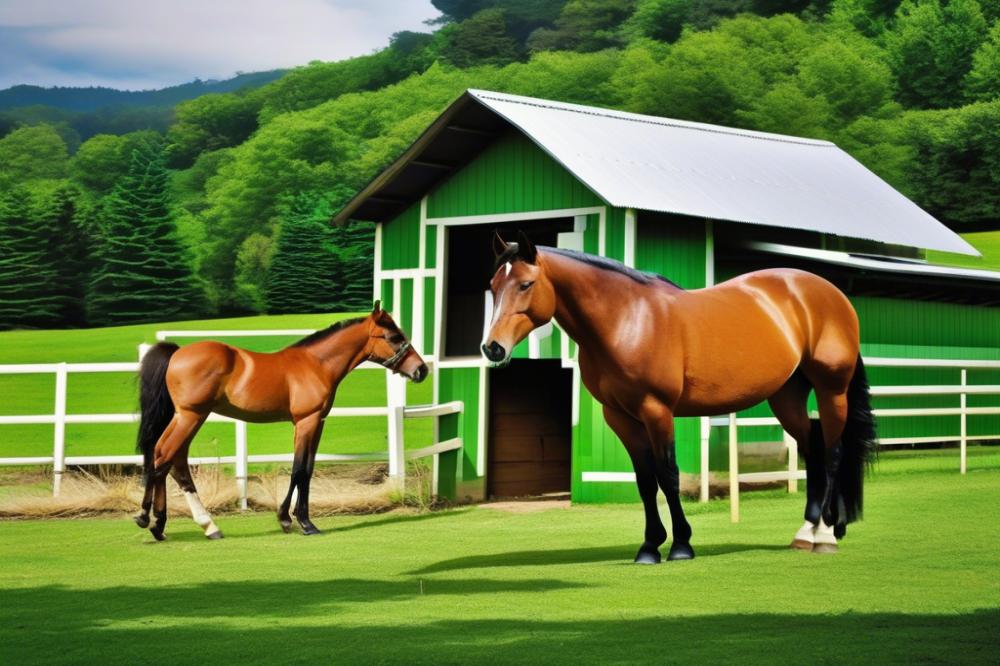Understanding Horse Breeding
Horse breeding is a complex process that involves pairing specific horses to produce offspring with desired traits. This practice has a rich history and has evolved significantly over time. Breeders aim for various goals, such as improving speed, temperament, or physical conformation. Each pairing is a calculated decision, often influenced by lineage, performance records, and the health of both parents.
Addressing breeding challenges is essential for anyone involved in the equine world. Understanding the common issues can help ensure better outcomes for both the mare and foal. Many factors affect successful breeding, including genetics, environment, and management practices. Recognizing these can save time, effort, and resources.
This article will explore several common obstacles faced in horse breeding. Topics will include genetic variability, health concerns, and management practices. Additionally, we will discuss strategies for overcoming breeding obstacles effectively. By arming yourself with this knowledge, you can enhance your breeding efforts and contribute to the overall success of your breeding program.
breeding challenges

Breeding challenges refer to the difficulties that arise during the process of reproducing plants or animals. These obstacles can affect the success of breeding efforts. Many factors come into play, making this a complex field. Understanding these issues is crucial for anyone involved in breeding.
Many breeders encounter health problems in their animals or plants. Genetics can play a major role in these difficulties. Some species may carry inherited issues that complicate reproduction. Environmental factors also contribute significantly. Poor living conditions can lead to stress, which might impact breeding. Another challenge is proper selection. Choosing the right pairings can often feel overwhelming. Breeders may struggle to find compatible traits that they want to pass on.
Recognizing these challenges is very important. Awareness allows breeders to take steps to address issues early. This can prevent bigger problems down the road. When breeders understand what they face, they can plan better. Trying out different techniques or strategies becomes easier. Knowledge of common challenges can lead to better overall success in breeding.
genetic diversity and Its Role

Understanding genetic diversity in horse breeding is pivotal. It refers to the range of different genes within a breed or population. A diverse gene pool allows for healthier offspring. Horses with a rich genetic background often show better adaptability and resistance to diseases.
Challenges arise when genetic diversity is limited. Breeding from a small group can lead to inbreeding. This practice causes genetic problems, such as reduced fertility or increased chances of inherited diseases. Issues may not appear immediately but can emerge over generations. A small gene pool can also limit the range of traits available for breeding.
Strategies to Promote Genetic Diversity in Breeding Programs
Utilizing several strategies can help promote genetic diversity. Expanding the breeding stock is essential. Introducing new individuals from different lines can refresh the gene pool. Collaboration with other breeders allows for sharing horses from various bloodlines. This practice naturally encourages mixing diverse genetics.
Incorporating artificial insemination is another effective method. This technique makes it easier to access a wider range of stallions without needing to travel. Additionally, identifying and using genetic testing can offer insights into a horse’s lineage. This knowledge makes it simpler to avoid inbreeding.
Managing breeding farms responsibly is a must. Keeping records on the lineage of each horse ensures informed breeding choices. Breeders should consider implementing rotational breeding systems. Rotating which horses are paired can help maintain genetic variety. Ultimately, increasing awareness around genetic diversity leads to better breeding practices.
Infertility Issues

Infertility can be a significant hurdle when breeding horses. Many factors contribute to this problem. One common cause is hormonal imbalances. These may disrupt the mare’s heat cycles. Another issue stems from physical conditions, such as reproductive tract infections. These infections can negatively impact fertility. Age also plays a role; older horses may face more challenges.
Health screenings are important to detect potential issues early. Regular veterinary check-ups can reveal hidden problems. Blood tests help assess hormone levels. Ultrasounds provide a clear view of reproductive organs. Assessing overall health can lead to better breeding outcomes. Understanding these factors is crucial for any breeding program.
Several solutions exist for infertility problems. Hormone therapy may correct imbalances. This can stimulate ovulation in mares. In some cases, antibiotics will treat infections effectively. Improved nutrition can also enhance overall reproductive health. Some programs even offer artificial insemination as an alternative method. Consulting with a veterinarian can guide owners on the best course of action.
Breeding Techniques and Animal Husbandry
Effective breeding techniques form the backbone of successful animal production. Understanding the specific needs of each species is essential. For example, rotational breeding can increase genetic diversity and improve health. Artificial insemination is another method that enhances the chances of conception. This technique allows for controlled breeding, reducing the risk of disease transmission.
Best Practices in Animal Husbandry
Proper care in animal husbandry plays a vital role in fostering healthy offspring. Providing a balanced diet is crucial. Nutrition directly impacts reproductive performance. Clean living conditions help reduce stress and the spread of diseases. Regular health checks are necessary to spot any potential issues early. Positive interactions with handlers can also lead to improved breeding results.
Importance of Care and Management
Managing the breeding process requires attention to detail. Keeping records of breeding dates, health histories, and offspring is helpful. This information allows for better decisions in future breeding. Monitoring behavior during mating is key to understanding compatibility. Animals need peace and quiet during this critical time. Disruptions can cause stress, leading to lower success rates.
During pregnancy, the needs of the mother change. Providing extra care, like proper nutrition and a comfortable space, is essential for her well-being. Preparation for birthing should also not be overlooked. A safe environment can help reduce complications. Staying vigilant during this period can save lives and improve outcomes.
The post-birth phase is often overlooked. Ensuring that both the mother and offspring receive proper care is equally important. Newborns require warmth, nutrition, and protection. Timely veterinary care can help maintain the health of both. Early intervention often improves survival rates significantly.
Environmental Factors
Impact of Environmental Factors on Breeding
Environmental conditions can greatly affect animal breeding. Temperature and humidity influence animal comfort. Stress from these factors can lead to lower reproductive rates. Poor weather can disrupt mating behaviors. Additionally, light exposure plays a role in reproductive cycles. Animals need the right amount of daylight for optimal breeding. Changes in these conditions can lead to unexpected challenges.
Strategies to Optimize Breeding Conditions
Creating a more suitable environment is crucial for successful breeding. Start by controlling temperature in barns or stables. Installing fans or heaters can help maintain comfortable conditions. Regularly monitoring humidity levels is also important. Adjusting ventilation can make a significant difference. Provide clean water and high-quality feed to support overall health. Healthy animals are more likely to breed successfully.
Role of Stable Management and Pasture Quality
Stable management affects how well animals breed. Keeping stables clean reduces the risk of disease. Regular bedding changes contribute to a healthier environment. Pasture quality should not be overlooked. Grazing on nutritious grass supports reproductive health. Rotating pastures can prevent overgrazing. Ensuring animals have enough space can reduce stress. All these factors work together to create a supportive environment for breeding.
Mating Programs and Reproductive Technology
Importance of Structured Mating Programs
Structured mating programs play a critical role in the success of animal breeding. These programs provide guidelines that help breeders select animals based on specific traits. By organizing the mating process, breeders can maximize genetic diversity. This approach reduces the chances of inbreeding. It also allows for better predictions regarding offspring traits. Each mating can be planned to achieve desired outcomes, such as better health or improved performance in livestock. Breeders often analyze lineage, health records, and physical characteristics. Such careful planning creates opportunities for better breed development.
Innovations in Reproductive Technology to Enhance Breeding Success
Innovations in reproductive technology have revolutionized animal husbandry. Techniques like genetic testing have opened new possibilities. Understanding an animal’s genetic makeup allows breeders to make informed choices. Additionally, advances in hormone treatments can improve breeding efficiency. The use of ultrasound technology for monitoring pregnancies is another important development. This helps breeders track reproductive cycles and improve the timing of matings. New methods continue to emerge, providing more tools to help breeders achieve their goals.
Use of Artificial Insemination and Embryo Transfer
Artificial insemination is a game-changer in modern breeding practices. This method enables breeders to use superior genetics without the need for physical contact between animals. Sperm can be collected and preserved, making it available for future use. This technique broadens the genetic pool and helps in selecting the best traits. On the other hand, embryo transfer allows for even greater control. By implanting embryos from high-quality donors into recipient females, breeders can enhance the genetic potential of their herds. These technologies work hand-in-hand, increasing the chances of successful breeding results. Adopting these strategies will help meet specific breeding goals more effectively.
Ethics in Breeding
Breeding animals is not just a scientific endeavor; it also carries serious ethical responsibilities. Individuals involved in this process must recognize their role in the lives of these creatures. It goes beyond producing a specific type or breed. The welfare of animals should always come first. Responsible choices can greatly affect the animals’ overall health and happiness.
Ethical practices lead to healthier populations and better living conditions. Poor breeding practices can result in serious health problems. For example, inbreeding can cause genetic issues that affect the animal’s quality of life. Think about the long-term effects of breeding decisions. Each animal deserves a chance to thrive, not just survive.
Animal welfare is a critical factor when making breeding decisions. Humans have a duty to provide a safe and nurturing environment. Avoiding unethical breeding not only prevents suffering but also promotes a positive image in the community. Consideration for each animal’s needs must be at the forefront of all breeding efforts.
Responsible breeding takes careful thought and planning. Potential breeders should ask themselves difficult questions. What health issues are common in the breed? How will they find suitable homes for the offspring? Having clear answers can lead to better outcomes. Prioritizing ethical standards encourages a healthier population in the future.
Ultimately, the decisions made in breeding can leave lasting impacts. Every choice should reflect the utmost respect for animal life. Poor practices can lead to dire situations. Always keep in mind the importance of doing what is right, not just what is easy.
Strategies for Overcoming Breeding Challenges
Tackling the difficulties of animal breeding requires careful planning and informed actions. Breeders should start by educating themselves on genetic principles and the specific needs of their animals. Gaining knowledge can lead to better decisions, resulting in healthier offspring.
Continuing research plays a crucial role in finding solutions. New studies can offer insights into genetics, health issues, and breeding methods. Staying updated allows breeders to adopt the latest techniques. Reading scientific articles, attending seminars, and joining relevant organizations can be beneficial.
Collaboration among different professionals can make a significant difference. Breeders, veterinarians, and geneticists often have unique perspectives. By working together, they can pool knowledge and experience for a common goal. Regular meetings and discussions foster innovation and creativity in breeding practices.
Additionally, utilizing technology can enhance the breeding process. Tools such as genetic testing help identify potential problems early. These advances allow breeders to make informed choices about their animals. Software can also simplify data management, making it easier to track genetics and health records.
Creating support networks is another effective strategy. Breeders can share challenges and successes with each other, leading to collective problem-solving. Online forums and local clubs offer great platforms to exchange ideas, tips, and resources. Having a community enhances motivation and confidence.
Wrapping Up Common Breeding Challenges
To recap, there are several obstacles that breeders often face. infertility issues can halt progress. Environmental factors, such as climate and habitat, play a major role. Inbreeding depression can endanger genetic diversity, which is essential for strong future generations. Understanding these potential pitfalls is the first step toward overcoming them.
Approaching breeding with knowledge and best practices is vital. Seek information from reliable sources. Connect with experienced breeders who can share their insights. Training and workshops can also be beneficial. Engaging with a community of fellow breeders offers support and encouragement.
Ultimately, successful breeding demands proactive strategies. Always prioritize animal welfare and ethical practices. Keeping accurate records can help track progress and identify areas for improvement. Consider implementing new techniques or technologies that could enhance breeding outcomes. This will contribute to both current and future success.
In closing, with dedication and informed strategies, it is possible to tackle common challenges head-on. Every decision made today shapes the future of breeding. Approach each project with care, ethical considerations, and a readiness to adapt. Together, we can create a brighter future for all breeds.



